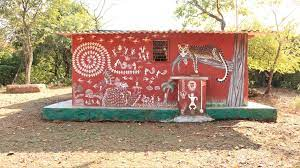Deifying of leopards by Maharashtra’s Warli tribe has prompted a better man-wild relationship
- ‘Waghoba’ is the institution under which the Warli tribe of Maharashtra has been worshipping leopards.
- Across India, worship of nature as gods and goddesses is a common practice. The latest study by the Wildlife Conservation Society (WCS) India has documented how a big cat worshipped as a deity by indigenous people, has facilitated the coexistence between humans and leopards. An example of Maharashtra’s Warli tribe has been cited in this regard, which explains that these people have been worshipping ‘Waghoba’ (a leopard or tiger deity) to gain protection from leopards, which has prompted their peaceful coexistence.
- This study was conducted by researchers affiliated with WCS-India, NINA, Norway, Inland Norway University of Applied Sciences, Norway and supported by Wildlife Conservation Trust. The fieldwork for the same was conducted between 2018 to 2019, across Mumbai suburban areas, Palghar and Thane districts of Maharashtra.
- To complete this study, an ethnographic approach was undertaken while collecting data where researchers conducted semi-structured interviews, participant observation and deeply understood all aspects of Waghoba, in the lives of the Warli. They also took part as an audience during the worship ceremonies, concurrent to documenting Waghoba shrines.
- This study, has been published in a special issue of Frontiers in Conservation Science: Human-Wildlife Dynamics, called ‘Understanding Coexistence with Wildlife’. The researchers have noted that though negative interactions with leopards continue, they find much acceptance under ‘Waghoba’ – the institution under which the Warli tribe worships leopards.
- Further, during this study, over 150 shrines dedicated to Waghoba have been identified, despite incidents like that of livestock deprivation due to wild attacks continue. The people belonging to Warli believe in a reciprocal relationship, hence, they continue annual traditions, such as ‘Waghbaras’, to spare themselves from the wrath of this deity.
- The lead author of this study was quoted saying- “The main aim of the study is to diversify the way we understand and approach human-wildlife interactions. It does so by shedding light on how local institutions that contribute to co-existence are not devoid of conflict but have a role in negotiating the conflicts that arise.”
Relevance of such institutions in the modern era
- Such local arrangements that allay the conflict between man and animal may exist in several other cultures and landscapes. These traditional arrangements are relevant in the modern era as they are likely to act as tolerance-building mechanisms and build an understanding of the term ‘peaceful coexistence among the upcoming generation.
- However, the authors of this study state that such conservation interventions are yet to recognise that landscapes have a history before their own point of entry into them. Moreover, when in the area of the Warli tribe, people have to address this issue with more caution as outsiders are no more dealing with just an animal, but a religious belief regarding which all cultures are sensitive.

